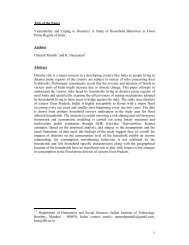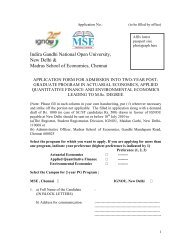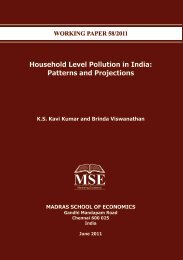Accounting for India's Forest Wealth - Madras School of Economics
Accounting for India's Forest Wealth - Madras School of Economics
Accounting for India's Forest Wealth - Madras School of Economics
- No tags were found...
Create successful ePaper yourself
Turn your PDF publications into a flip-book with our unique Google optimized e-Paper software.
around 30 percent in the first period, and would require a carbon tax <strong>of</strong>$56 per tonne.Manresa and Sancho (2005) follow the tradition <strong>of</strong> appliedgeneral equilibrium modelling <strong>of</strong> the Walrasian static variety to study theempirical viability <strong>of</strong> a double dividend (green, welfare, and employment)in the Spanish economy. They consider a counterfactual scenario inwhich an eco-tax is levied on the intermediate and final use <strong>of</strong> energygoods. Under a revenue neutral assumption, they evaluate the realincome and employment impact <strong>of</strong> lowering payroll taxes. They per<strong>for</strong>msimulations under a range <strong>of</strong> alternative model and policy scenarios toassess the extent the model structure and behavioural assumptionsinfluence the results. They conclude that a double dividend (betterenvironmental quality, as measured by reduced CO 2 emissions andimproved levels <strong>of</strong> employment) may be an achievable goal <strong>of</strong> economicpolicy.Sterner (2007) provides a review several studies <strong>for</strong> a number <strong>of</strong>countries and concludes; “Had Europe not followed a policy <strong>of</strong> high fueltaxation but had low U.S. taxes, then fuel demand would have beentwice as large”. Sterner observes that fuel taxes are the single mostpowerful climate policy instrument implemented to date. Environmentaltax re<strong>for</strong>m can have a powerful effect on energy use.Ekins (2009) estimates the price elasticity <strong>of</strong> energy demand inthe UK at about (-) 0.64, which implies that a 10 percent increase in theenergy price will reduce energy consumption by 6.4 percent. He als<strong>of</strong>inds that energy use tends to increase with value added with anelasticity <strong>of</strong> (+) 0.5 (meaning that a 10 percent increase in value addedwill tend to increase energy consumption by 5 percent). Other thingsbeing equal, this means that if a sector (or by implication the economy asa whole) is growing, its energy use will be growing too, unless it isrestrained by a rising energy price.7


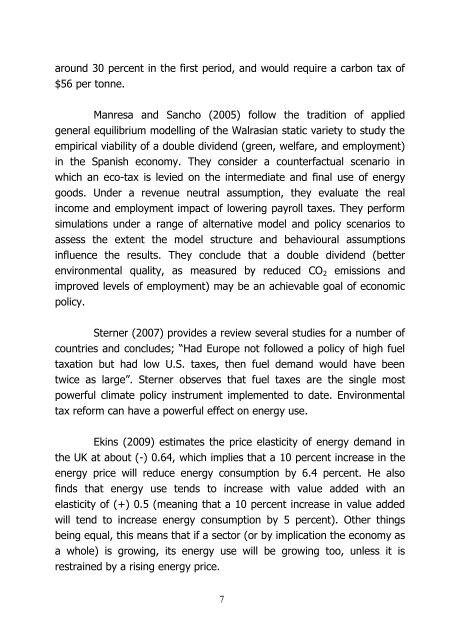
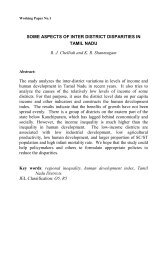

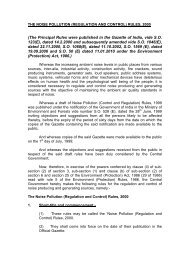
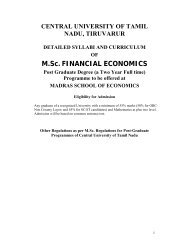
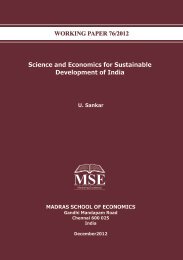
![Curriculum Vitae [pdf] - Madras School of Economics](https://img.yumpu.com/49878970/1/190x245/curriculum-vitae-pdf-madras-school-of-economics.jpg?quality=85)
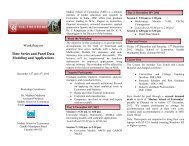
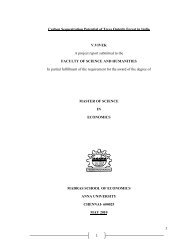
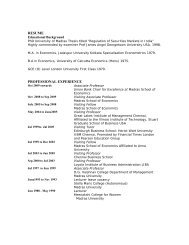
![Curriculum Vitae [pdf] - Madras School of Economics](https://img.yumpu.com/48715201/1/184x260/curriculum-vitae-pdf-madras-school-of-economics.jpg?quality=85)
